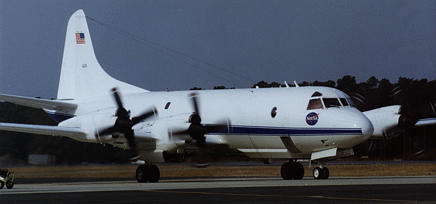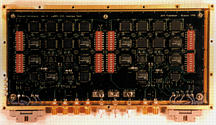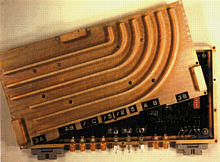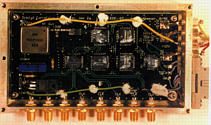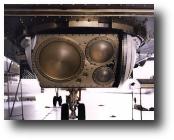 PSR as installed on the NASA Orion P-3B aircraft. |
Polarimetric Scanning Radiometer
Instrument Description
The Polarimetric Scanning Radiometer (PSR) is a versatile airborne microwave imaging radiometer developed by the Georgia Institute of Technology and the NOAA Environmental Technology Laboratory (now NOAA/ESRL PSL) for the purpose of obtaining polarimetric microwave emission imagery of the Earth's oceans, land, ice, clouds, and precipitation. The PSR is the first airborne scanned polarimetric imaging radiometer suitable for post-launch satellite calibration and validation of a variety of future spaceborne passive microwave sensors. The capabilities of the PSR for airborne simulation are continuously being expanded through the development of new mission-specific scanheads to provide airborne post-launch simulation of a variety of existing and future U.S. sensors, including CMIS, ATMS, AMSU, SSMIS, WindSat, TMI, RAMEX, and GEM.
The basic concept of the PSR is a
set of polarimetrc radiometers housed within a gimbal-mounted scanhead drum.
The scanhead drum is rotatable by the gimbal positioner so that the radiometers
(Figure 2.) can view any angle within ~70°
elevation of nadir at any azimuthal angle (a total of 1.32 ![]() sr solid angle), as
well as external hot and ambient calibration targets. The configuration thus
supports conical, cross-track, along-track, fixed-angle stare, and spotlight
scan modes. The PSR was designed to provide several specific and unique
observational capabilities from various aircraft platforms. The original design
was based upon several observational objectives:
sr solid angle), as
well as external hot and ambient calibration targets. The configuration thus
supports conical, cross-track, along-track, fixed-angle stare, and spotlight
scan modes. The PSR was designed to provide several specific and unique
observational capabilities from various aircraft platforms. The original design
was based upon several observational objectives:
- To provide fully polarimetric (four Stokes' parameters: Tv, Th, TU, and TV) imagery of upwelling thermal emissions at several of the most important microwave sensing frequencies (10.7, 18.7, 37.0, and 89.0 GHz), thus providing measurements from X to W band;
- To provide the above measurements with absolute accuracy for all four Stokes' parameters of better than 1 K for Tv and Th, and 0.1 K for TU and TV;
- To provide radiometric imaging with both fore and aft look capability (rather than single swath observations);
- To provide conical, cross-track, along-track, and spotlight mode scanning capabilities; and
- To provide imaging resolutions appropriate for high resolution studies of precipitating and non-precipitating clouds, mesoscale ocean surface features, and satellite calibration/validation at Nyquist spatial sampling.
The original system has been extended - as discussed below - to greatly exceed the original design objectives by providing additional radiometric channels and expanded platform capabilities.
The PSR scanhead (Figure 2.) was
designed for in-flight operation without the need for a radome (i.e., in direct
contact with the aircraft slipstream), thus allowing precise calibration and
imaging with no superimposed radome emission signatures. Moreover, the conical
scan mode allows the entire modified Stokes' vector to be observed without
polarization mixing.
The entire assembly (including both scanhead and positioner) was designed for integration into several different aircraft, including:
- NASA Dryden Flight Research Center’s DC-8 (nadir-7 and/or nadir-2 ports)
- NASA Wallops Flight Facility's Orion P-3B (aft end of the P-3 bomb bay) (Figure 1)
- Scaled Composites Proteus underbody pod
- NASA Johnson Space Center’s WB-57F (palletized bomb bay)
- NASA Dryden Flight Research Center’s ER-2 (Q-bay)
To date, the PSR has flown successfully for over 340 flight hours on NASA and Navy P-3's and the NASA DC-8 in conjunction with several major field experiments sponsored by the US. Office of Naval Resarch (ONR), NASA, NPOESS Integrated Program Office (IPO), NOAA, U.S. Navy, and the U.S. Department of Agriculture. During all flights the PSR exhibited excellent aerodynamic, mechanical, and electrical performance in ambient conditions as cold as -51° C and at true air speeds up to 375 knots.
The PSR/A scanhead provides either full-Stokes vector or tri-polarimetric sensitivity at the radiometric bands of 10.7, 18.7, and 37 GHz, and thus is well suited for the NPOESS Integrated Program Office’s internal government (IG) studies of ocean surface wind vector measurements - as proposed for inclusion on NPOESS. Currently, PSR data has been used to demonstrate the first-ever retrieval of ocean surface wind fields using conically-scanned polarimetric radiometer data. The results have suggested that the NPOESS specification for wind vector accuracy will be achievable with a polarimetric two-look system.
A. Polarimetric Radiometers: PSR/D
The first PSR scanhead (denoted "PSR/D," for its use of digital correlators) was developed in 1995-96 and consisted of four polarimetric radiometers operating at 10.7, 18.7, 37.0, and 89.0 GHz (see Piepmeier and Gasiewski, 1996a). In order to efficiently utilize the scanhead faceplate area, the 10.7 and 37.0 GHz radiometers utilize a common dual-band antenna, while the 18.7 and 89.0 GHz receivers each utilize single-band antennas. The precise radiometric bands measured by the PSR are X (10.6-10.8 GHz), Ku (18.6-18.8 GHz), Ka (36-38 GHz), and W (86-92 GHz). These bands were selected to provide sensitivity to clouds, precipitation, and surface features over almost one decade of microwave bandwidth at octave intervals.
All antennas are of the lens/corrugated feedhorn type and are dual orthogonal-linear polarized with grooved rexolite lenses. Antenna diameters were chosen to provide beamwidths of 8° (for both X- and K-bands) and 2.3° (for both Ka- and W-bands). All main beam efficiencies are in the 95-97% range and all on-axis cross-polarization isolations exceed -27 dB.
The microwave receivers in PSR/D were all dual-channel superheterodyne with a common local oscillator driving each of two identical mixers. The 10.7 and 18.7 GHz receivers were single sideband (SSB) and use high electron mobility transistor (HEMT) preamplifiers, while the 37.0 and 89.0 GHz receivers are double sideband (DSB). Noise temperatures are low enough to meet the required sensitivities for airborne radiometric studies of ocean emission anisotropies, clouds, and precipitation.
Tri-polarimetric detection (Tv=<|Ev|2>,
Th=<|Eh|2>, and TU=2![]() e
<EvEh*>) was accomplished in PSR/D using
custom three-level (1.6-bit) digital correlators operating at 1 GS/sec (Piepmeier and Gasiewski, 1996b). The correlators
allowed detection and cross-correlation of 500 MHz wide intermediate frequency
bands at the Nyquist sampling rate. High-speed ECL logic was used to accomplish
the digital detection (Figure 3.). IF subband division was
used to allow detection of the full IF bandwidths available from the various
receivers (up to 2000 MHz). The digital detection hardware was backed up by
redundant dual-polarization analog detection hardware.
e
<EvEh*>) was accomplished in PSR/D using
custom three-level (1.6-bit) digital correlators operating at 1 GS/sec (Piepmeier and Gasiewski, 1996b). The correlators
allowed detection and cross-correlation of 500 MHz wide intermediate frequency
bands at the Nyquist sampling rate. High-speed ECL logic was used to accomplish
the digital detection (Figure 3.). IF subband division was
used to allow detection of the full IF bandwidths available from the various
receivers (up to 2000 MHz). The digital detection hardware was backed up by
redundant dual-polarization analog detection hardware.
The PSR/D scanhead (Figure 4) contains an 80486 PC, an eight-channel digital correlator bank, and four total- power tri-polarimetric radiometers installed inside a 20" (51 cm) diameter and 20" (51 cm) long rotating drum. Radiometric data is processed using a 80486-based computer within the scanhead, then transmitted to an archival computer in the aircraft cabin via a 10-base 2 LAN link through the sliprings. Thus, all radiometric detection is accomplished inside the scanhead drum.
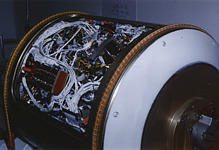
|
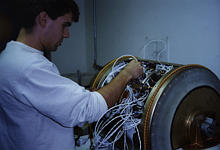
|
| Figure 4. PSR scanhead as seen through the access cover illustrating wiring and microwave electronics. | |
The scanhead package includes a monochrome CCD telephoto video camera boresighted along the antenna main beams. The camera incorporates an orange filter and vertical polarizer to maximize the contrast of ocean foam against the ocean background and clouds against either ocean or land backgrounds. The camera is used to observe the scene for purposes of cloud clearing, ocean foam coverage estimation, and surface feature detection.
B. Scanning Mechanism
To provide the required imaging capabilities a nadir-viewing two-axis gimbal mount is used to scan the PSR radiometers in the airstream outside the aircraft. The gimbal mount utilizes a 30-inch diameter ring bearing to support a nominal aerodynamic wind load of up to 600 lbs. To avoid calibration problems no radome is used, however an aerodynamic fence is used to reduce the maximum free-stream wind loading to ~170 psf which is appropriate for the gimbal and scanhead structure. Geared stepper motors with ~135 N-m of torque along with 12-bit absolute position encoders facilitate scanhead motion under nominal wind loading. Structural torsional deflections have been designed to be less than 0.01° to maintain positioning accuracy. Scanhead power is provided by azimuthal and elevation slip rings provide power to the scanhead.
The 170-lb scanning drum can be positioned to view any angle with 0.1° precision using a two-axis high-torque stepper motor positioner system driven by a dedicated 68000-based programmable controller. Sliprings are used to provide power to the scanhead and to facilitate digital and analog data communications via ethernet and NTSC video links. In order to minimize damage to the electronics caused by condensation, a dry gas system is used to purge the scanhead drum and sliprings. The weight of the positioner alone is 437 lbs, yielding a total instrument weight (less computer control hardware) of 607 lbs. An additional 200-400 lbs (depending on the specific aircraft platform) is required for computer control hardware. Positioner and calibration load power requirements vary with the motor's dynamic loads and with ambient temperature, but the maximum required power (during warmup on ascent) is less than 1500 watts at 120 VAC. Scanhead power consumption is an additional 240 watts at 28 VDC.
All scan modes are software-selectable in flight, and include: (1) conical, with either fixed-angle or stepped-angle cones and including both fore and aft views, (2) cross-track or along-track, (3) fixed-angle stare, including nadir and (during modest rolls) cold sky stare, and (4) spotlight. Minimum scan times of ~10 seconds for a complete fore-and-aft viewing cone with 53.1° half-angle (or ~4 seconds without hot and cold calibration views) are attained in-flight with excellent mechanical stability. A network of IRIG-B clocks within the scanhead and controlling computers provides position/sample synchronization to better than one millisecond. A two-axis gyroscope is mounted on the positioner to provide roll and pitch information at ~10 msec intervals. These data are later used to correct the observed imagery for minor aircraft attitudinal variations.
C. Calibration
Calibration of all radiometers is performed in-flight using standard (unpolarized) hot and cold blackbody targets. The unpolarized load consists of an array of canted pyramidal iron-epoxy absorbing wedges organized in a two-faced L-shaped configuration (Figure 5). The absorbing pyramids overlie a thermally-conducting substrate of aluminum pyramids so that the physical temperature of the entire structure remains homogeneous to within 1-2 K. The microwave emission temperature of the structure is thus precisely calculable using measurements of the physical temperature of the array. The pyramids are canted at an angle of 45° so as to provide maximum absorption in the direction of PSR lens antennas. The dimensions of each pyramid were chosen so as to maximize absorption over the entire band of frequencies used by the PSR.
D. PSR/A: Recent Innovations in preparation for the NASA CAMEX3 Experiment
Several major improvements in the scanhead and data system have been implemented in preparation for the CAMEX-3, thus leading to a second (analog) iteration of the original scanhead (PSR/A) (Figure 6). First, the 18-GHz feedhorn and receiver has been upgraded to cover two radiometric bands and now includes a fully-polarimetric channel at 18.6-21.7 GHz, and a dual-polarized water vapor channel at 21.3-21.6 GHz. The new K-band receiver will thus be sensitive to emissions from both the surface and integrated water vapor. The new receiver will also be a direct detecting type rather than superheterodyne. Second, each of the five radiometers will incorporate sub-interval calibration hardware to supplement the standard hot- and ambient-view calibration. The sub-interval calibration hardware will switch noise diodes into the RF inputs of the receivers at ~100 msec intervals, pulsing each diode both on and off so as to allow estimation of the radiometer gains and offsets at time intervals comparable to the drift time of receivers. In this manner, uncalibrated gain and offset drift caused by 1/f noise will be significantly reduced. Third, the digital correlators were replaced by analog adding correlators using quadrature hybrid arrays. The analog system allows measurement of all four Stokes' parameters for the 10- and 18-GHz channels, and the first three Stokes' parameters for the 37- and 89-GHz channel. Finally, using a new pyramidal calibration load (expected to be available in late 1998), the absolute accuracy of the PSR is expected to be ~1 K, thus providing excellent capabilities for absolute intercomparisons of measurements with radiative transfer model calculations.
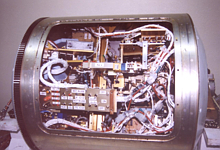
|

|
| Figure 6. PSR/A scanhead illustrating internal construction and installation on the NASA DC-8 in preparation for CAMEX-3. | |
E. New Developments: PSR/C, PSR/S, and PSR/L
The modularity of the PSR system allows for a straightforward replacement of the scanhead under field conditions with either of several new or planned scanheads. The replacement of a scanhead requires approximately two-hours of time and can thus be can be accomplished well within the duration of a typical field campaign. The logical, electrical, and mechanical interfaces to the new scanheads are all identical, thus minimizing design and fabrication costs as well as providing observational versatility. Additional PSR gimbal positioners are being fabricated in order to allow more than one PSR scanehad to be operated from a single aircraft. Synchronized operation of two PSR systems is possible on the DC-8, P-3, WB-57F, or Proteus aircraft.
PSR/CRemote sensing of soil moisture using C- and X-band microwave frequencies provides less penetration of vegetation and soil probing depth than L-band, but is more amenable to implementation using airborne or spaceborne antennas of practical size. The Japanese AMSR-E imaging radiometer on board the NASA EOS Aqua satellite is one such sensor capable of retrieving soil moisture using a microwave channel at 6.9 GHz with ~75 km spatial resolution. Aqua was launched in May 2002, and will provide a global soil moisture product based on AMSR-E data. The C-band channels on the future NPOESS Conical Microwave Imager and Sounder (CMIS) will provide new operational capabilities for mapping soil moisture. Sea surface temperature is also observable under most cloud conditions using passive microwave C-band radiometry.
To provide airborne mapping capabilities for measuring both soil moisture and sea surface temperature a second operational PSR scanhead was built incorporating fully polarimetric C- and X-band radiometers inside a standard PSR scanhead drum. The C-band radiometer in PSR/CX provides vertically and horizontally polarized measurements within four adjacent subbands at 5.80-6.20, 6.30-6.70, 6.75-7.10, and 7.15-7.50 GHz. In addition, the radiometer provides fully polarimetric measurements at 6.75-7.10 GHz. The use of four subbands and polarimetric capability has provided a unique means of demonstrating and optimizing algorithms for RFI mitigation.
PSR/CX was originally implemented using only a C-band radiometer (as PSR/C) in preparation for SGP99. In preparation for SMEX02 an X-band radiometer was added to provide vertically and horizontally polarized measurements within four bands at 10.60-10.68, 10.68-10.70, 10.70-10.80, and 10.60-10.80 GHz. Fully polarimetric measurements are provided within 10.60-10.80 GHz. The combined dual-band system provides additional information on soil moisture, along with the capability to measure precipitation and the near-surface wind vector over water backgrounds. The X-band channels also provide additional RFI mitigation capability.
Applications of PSR/CX include ocean surface emissivity studies, soil moisture mapping, sea ice mapping, and imaging of heavy precipitation. Recently, an interference detection and removal algorithm suitable for spaceborne application was demonstrated using PSR/C and PSR/CX data.
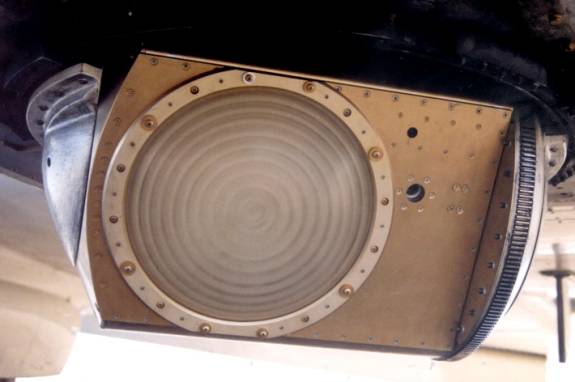
|
|
Figure 7. PSR/C scanhead. The primary lens/feedhorn antenna is located to the left of a co-boresighted video camera and longwave (10um) IR sensor. |
PSR/S. A “submillimeter” wavelength scanhead, PSR/S, with radiometers operating at the temperature and moisture sounding bands on AMSU/A and B is currently being fabricated. This scanhead will contain several dual-orthogonal linearly polarized millimeter- and submillimeter wave radiometers with frequencies ranging from 18.7 to 500 GHz. This system (PSR/S) is being designed to study the polarization signatures of clouds and precipitation and will provide dual-polarized sensitivity at all major window channels in this range. When completed, this instrument will provide NOAA with the first-ever capability to perform comprehensive post-launch calibration of its AMSU sensors - and the first ever in-house capability for this critical acceptance task. PSR/S will also be ideally suited for post-launch calibration of all NPOESS microwave sensors (ATMS and CMIS) along with the ATMS on the NPOESS Preparatory Project (NPP).
The PSR/S scanhead will have several sub-millimeter-wave channels, providing sensitivity to cirrus water content and upper tropospheric water vapor. These sensing capabilities will be used to study the distributions of ice and water phases around convective sources. Since water vapor is the most important of greenhouse gasses, the use of this scanhead will provide important information on natural mechanisms for stratospheric water vapor exchange.
The submillimeter-wave channels on PSR/S will be provide simulation capability for the Geosynchronous Microwave (GEM) Sounder, now under consideration for the NOAA GOES series of satellites. GEM has been proposed as a practical geosynchronous microwave sounder, providing sounding channels at 118, 183, 380, and 424 GHz with spatial resolution of ~15-20 km and rapid scanning and update capability. Here, the PSR/C and PSR/S scanheads - used in tandem - will provide important radiometric imagery necessary to determine the capabilities of a proposed microwave sensor to sound temperature and humidity from geosynchronous orbit. The combination of PSR/C and PSR/S scanheads will provide the first means of intercomparing the data available from the GEM-class sounder with data from well-understood systems such as AMSU and SSM/I.
PSR/L.Remote sensing of soil moisture can be accomplished under most vegetation conditions using L-band (~1.4 GHz) microwave radiometry. Such data provides good penetration of crop and vegetation canopy as well as measurements of soil moisture at soil depths of up to ~10 cm. A new conically-scanning PSR scanhead operating at L-band (PSR/L) promises to provide more accurate maps of sea surface salinity than currently available. The high resolution of the PSR/L airborne sensor will be particularly valuable for coastal and estuarian salinity mapping and sea ice melt research.
